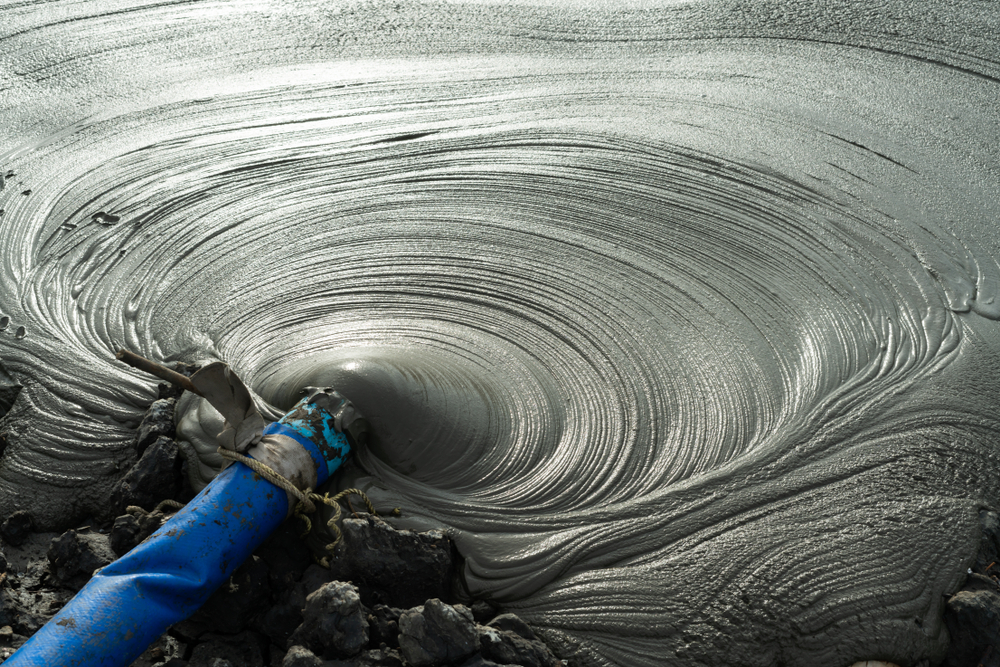Mud pH Stability Testing
Mud pH stability testing is a critical process in the oil and gas sector that ensures optimal drilling fluid performance. Drilling mud, or drilling fluids, are used extensively to lubricate and cool the drill bit while also transporting cuttings from the borehole to the surface. The pH level of these fluids plays a pivotal role in their efficiency and safety during drilling operations. An ideal pH range for drilling mud is typically between 8.5 and 9.5, as this range ensures that the mud remains effective under various conditions.
The stability of mud pH is crucial because it can affect numerous aspects of the drilling operation, including:
- Formation damage prevention
- Mud filtration characteristics
- Mud viscosity and rheology
- Torque on the drill bit
- Drilling speed
To maintain optimal pH stability, it is essential to understand the chemical composition of drilling muds. These fluids are composed of water, clay, weighting agents, lubricants, and chemicals that enhance specific properties such as filtration control or wettability. The pH value can be influenced by various factors during the drilling process, including the interaction with formation rocks and the introduction of new additives.
Mud pH stability testing involves a series of steps to accurately measure and monitor changes in pH over time and under different conditions. This is typically done using a combination of titration methods and automated pH meters that can provide precise readings. The testing process often includes:
- Sampling the mud at various stages of drilling
- Adjusting the mud mixtures to achieve targeted pH levels
- Monitoring changes in pH after introduction of new additives or during prolonged exposure to formation materials
The results from these tests are used by quality managers, compliance officers, and R&D engineers to ensure that the drilling fluids meet stringent industry standards. This testing process is particularly important for ensuring safety and efficiency in oil and gas operations.
Industry Applications
| Application |
Description |
| Mud pH Stability Testing in Offshore Drilling |
Ensures that drilling fluids do not damage the subsea environment and maintain their performance under extreme pressure conditions. This is critical for protecting marine ecosystems. |
| Shallow Well Operations |
Mud pH stability testing helps in maintaining optimal fluid properties even at shallower depths, where the interaction with formation rocks can be more aggressive. |
| Enhanced Oil Recovery (EOR) |
Testing is essential to ensure that the fluids used for EOR are safe and efficient in enhancing oil extraction without causing harm to the surrounding geological formations. |
| Drilling Fluids for Geothermal Drilling |
Mud pH stability testing is crucial here as it can significantly influence the temperature and pressure conditions that geothermal drilling must withstand. Proper pH control ensures fluid integrity. |
These applications highlight the importance of mud pH stability testing in ensuring environmental responsibility, operational efficiency, and safety across various drilling environments.
International Acceptance and Recognition
Mud pH stability testing is widely recognized by international standards such as ISO, ASTM, and API. The International Organization for Standardization (ISO) provides guidelines that are applicable to a broad range of industries, including oil and gas. Similarly, the American Society for Testing and Materials (ASTM) offers specific test methods relevant to drilling fluids.
In the context of drilling muds, the American Petroleum Institute (API) is particularly influential. API specifications such as API RP 13B2 provide detailed procedures for testing and ensuring that mud pH stability meets industry best practices. These standards are designed to ensure that the tests conducted are consistent across different laboratories and operators.
Compliance with these international standards is essential for companies in the oil and gas sector. It not only ensures that their operations meet regulatory requirements but also builds trust among stakeholders, including clients, regulators, and environmental groups.
Environmental and Sustainability Contributions
Mud pH stability testing plays a crucial role in enhancing sustainability within the oil and gas sector. By ensuring optimal pH levels, companies can minimize their environmental impact during drilling operations. Properly controlled mud pH helps prevent formation damage, which is detrimental to both the environment and the integrity of the well.
Additionally, maintaining stable mud pH reduces the risk of spills or leaks, which can have severe consequences for aquatic life and nearby ecosystems. This testing also supports the use of sustainable practices by ensuring that drilling fluids are compatible with the geological formations they encounter.
The benefits extend beyond environmental protection to include operational efficiency. Stable mud pH ensures consistent performance, reducing downtime due to fluid-related issues. This leads to more efficient operations and lower costs for companies in the sector.
Frequently Asked Questions
What is mud pH stability testing?
Mud pH stability testing involves measuring and monitoring the pH level of drilling fluids over time to ensure optimal performance under various conditions.
Why is mud pH stability important in oil and gas drilling?
Mud pH stability ensures that drilling fluids remain effective, preventing formation damage and maintaining fluid properties critical for efficient operations.
What are the common methods used in mud pH stability testing?
Common methods include titration tests and using automated pH meters to provide precise readings at different stages of drilling.
How often is mud pH stability tested during a drilling operation?
Testing frequency depends on the specific conditions, but it is typically conducted regularly throughout the drilling process to ensure optimal performance.
Which international standards apply to mud pH stability testing?
International standards such as ISO, ASTM, and API provide guidelines for testing and ensuring that mud pH stability meets industry best practices.
What are the environmental benefits of stable mud pH?
Stable mud pH helps minimize environmental impact by preventing formation damage, reducing the risk of spills, and supporting sustainable drilling practices.
How does mud pH stability testing contribute to operational efficiency?
By ensuring consistent performance, stable mud pH reduces downtime due to fluid-related issues, leading to more efficient operations and lower costs.





